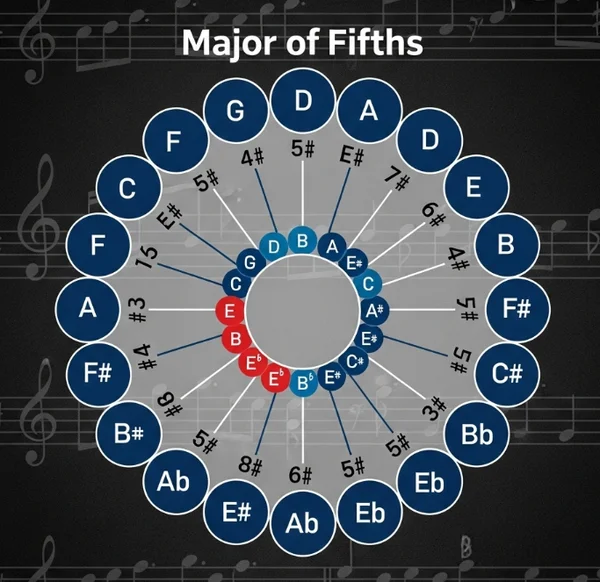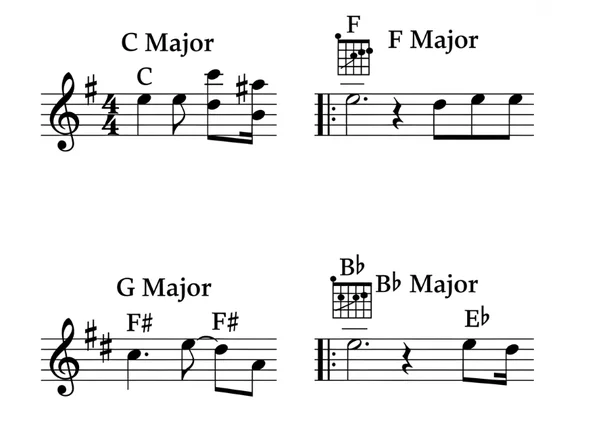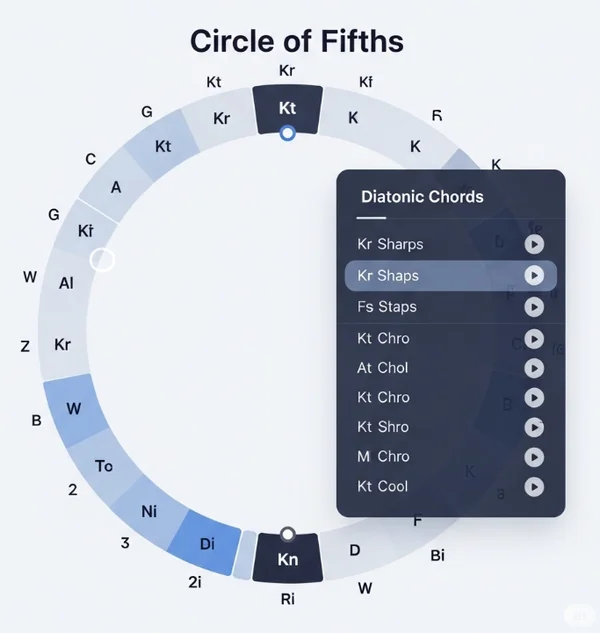Find Song Key with Circle of Fifths: A Step-by-Step Guide
Have you ever admired how experienced musicians seem to just know a song's key? That secret isn't magic; it's a skill grounded in music theory, with the Circle of Fifths as their essential roadmap. This powerful concept reveals the underlying harmony, making it simpler to grasp, perform, and even write music. But how exactly do you find the key of a song using the Circle of Fifths efficiently? This guide will show you, using the intuitive and interactive Circle of Fifths tool to make key identification genuinely straightforward.
Why Identifying a Song's Key Matters for Musicians
Knowing a song's key is foundational to nearly every aspect of musical engagement. It provides the harmonic framework, dictating which notes and chords will sound "right" and which will create tension. For anyone learning, playing, or composing, this knowledge is invaluable.
The Role of Key Signatures in Music Theory
At its core, a song's key defines its central tonal center. This is visually represented by key signatures – the sharps or flats placed at the beginning of a staff. These symbols tell you which notes are consistently raised or lowered throughout the piece, establishing the tonal landscape. Understanding these signatures is the first step in unlocking a song's harmonic identity.
How Knowing the Key Boosts Your Playing & Composing
For instrument players, knowing the key instantly provides a roadmap for scales, arpeggios, and improvisational ideas. It allows you to confidently transpose songs, play by ear, and navigate the fretboard or keyboard with greater fluidity. For aspiring songwriters and composers, identifying the key is crucial for crafting compelling chord progressions, understanding harmonic relationships, and seamlessly transitioning between different sections or keys. It helps you write music that sounds coherent and emotionally resonant, moving beyond just random chords.
The Circle of Fifths Explained: Your Key Finder Map
The Circle of Fifths is a visual representation of the relationships between the twelve musical keys. It's a fundamental concept in music theory, acting as a powerful navigational tool for understanding key signatures, chords, and modulation. Think of it as a compass for your musical journey. Moving clockwise, keys progress by perfect fifths (e.g., C to G, G to D), adding sharps. Moving counter-clockwise, keys progress by perfect fourths (or descending fifths), adding flats.

Understanding the Order of Sharps and Flats
One of the most practical applications of the Circle of Fifths is its direct correlation with key signatures. The order of sharps (F-C-G-D-A-E-B) and flats (B-E-A-D-G-C-F) is intrinsically linked to the circle. As you move clockwise, each new key adds one more sharp, following the order of sharps. For example, G major (one sharp, F#) is one step clockwise from C major (no sharps/flats). D major (two sharps, F#, C#) is another step. This makes it incredibly easy to memorize the circle of fifths and the associated key signatures.

Relative Minors and the Circle's Dual Nature
A key feature of the circle of fifths is its ability to reveal relative minors. Every major key has a corresponding minor key that shares the exact same key signature. This relative minor is always found three half-steps below its relative major. For example, A minor is the relative minor of C major, both having no sharps or flats. On our interactive tool, the relative minor is clearly displayed for any major key you select, illustrating their shared tonal DNA.
Step-by-Step: How to Find the Key of a Song
Identifying a song's key involves a bit of detective work, combining listening skills with theoretical knowledge. Here's how to find the key of a song:
Analyze the Melody: Spotting the Tonic and Leading Tone
Start by listening closely to the melody. The tonic (the "home" note of the key) often feels like the resting point, the note where phrases resolve. It's frequently the first or last note of a melody, or a strong note that recurringly appears. Also, listen for the leading tone, which is the note a half-step below the tonic. This note has a strong pull upwards towards the tonic, creating a sense of resolution. For example, in C major, the tonic is C and the leading tone is B. Identifying these two notes can give you a very strong hint about the underlying key.
Examine the Harmony: Common Chord Progressions and Diatonic Chords
Next, pay attention to the song's harmony. The most important chords in a key are the tonic (I), dominant (V), and subdominant (IV). These are known as the diatonic chords and form the backbone of most chord progressions. Listen for the most frequently occurring chords, especially those that feel like they provide a sense of home or resolution. The tonic chord (the I chord) will typically be the one that provides the strongest sense of arrival. You'll also want to observe other common chords within the key. For instance, what are the chords in C major? They are C, Dm, Em, F, G, Am, Bdim. Identifying these common patterns helps narrow down the possibilities.

Confirming with Accidentals: Sharps and Flats
Finally, look for any accidentals (sharps or flats that are not part of the key signatures but appear temporarily in the music). If you have sheet music, the key signature at the beginning of the staff will be your primary clue. If not, note any recurring sharps or flats in the melody or harmony. For example, if you consistently hear F# and C#, the song is likely in D major. If you see Bb and Eb, it's likely Ab major. The accidental that appears most frequently (especially if it resolves strongly) often points to the a leading tone or a modulation. This helps confirm your initial melodic and harmonic hypotheses.
Leverage Our Interactive Tool for Instant Key Identification
Once you've done your musical detective work, our interactive circle of fifths tool at CircleOfFifths.io becomes your most powerful ally for confirming your findings and exploring musical relationships.
Visualizing Your Findings with the Interactive Chart
Our circle of fifths chart is designed to be highly intuitive. Simply click on any major or minor key on the interactive wheel, and you'll instantly see its corresponding key signature, relative minor, and all the diatonic chords within that key. This visual feedback helps you quickly verify your analysis from the steps above. If you suspect a song is in G major, clicking on "G" will instantly show you the one sharp (F#) and the major, minor, and diminished chords associated with it. Explore the chart yourself to see this in action.
Testing Your Key Discovery with Diatonic Chord Playback
One of the unique advantages of our tool is the ability to hear the chords. After selecting a key, you can click on any of the listed diatonic chords to hear how it sounds. This chord playback feature is invaluable for reinforcing your understanding and training your ear. Did you identify a major chord in your song that sounds like the dominant (V) chord of your suspected key? Click the V chord on our tool and listen! Does it match? This real-time auditory feedback makes the learning process incredibly engaging and effective for circle of fifths application. Ready to put your knowledge to the test? Try our free tool today and hear the theory come to life.

Master Key Identification with the Circle of Fifths
Ultimately, truly understanding a song begins with key identification – a vital skill for every musician. By combining keen listening, a grasp of harmony and key signatures, and the indispensable Circle of Fifths, you gain the power to truly understand any piece of music. Our free, interactive Circle of Fifths tool transforms abstract music theory into a tangible, exciting experience. It's not just a chart; it's your personal guide to visualizing, hearing, and internalizing the connections that bring music to life. Ready to unlock new levels of musical understanding? Dive into the circle of fifths on our site today!
Frequently Asked Questions About Finding Song Keys
How to use the circle of fifths to identify a song's key?
To identify a song's key using the circle of fifths, first listen for the song's "home" note (tonic) and common chord progressions. Note any consistent sharps or flats. Then, use an interactive tool like our Circle of Fifths chart to match these observations with a key on the circle. The tool will show you the key signatures and diatonic chords that correspond to each key, helping you confirm your analysis.
What is the main purpose of the Circle of Fifths in music theory?
The main purpose of the Circle of Fifths in music theory is to visually organize the relationships between the 12 major and minor keys. It helps musicians understand key signatures, harmonic distance, relative minors, and how keys relate to each other, making it an essential tool for composition, improvisation, and analysis.
Can the Circle of Fifths help me find a song's relative minor?
Yes, absolutely! The Circle of Fifths explicitly shows relative minors. Each major key on the outer ring of the circle has a corresponding relative minor key located three half-steps (or minor third) below it. On our interactive tool, the relative minor is clearly displayed for any major key you select, simplifying this connection.
What are the chords in a specific major key, and how does the Circle of Fifths show them?
The Circle of Fifths doesn't directly list all chords for a key on its basic diagram, but an interactive tool like our Circle of Fifths chart does! When you select a specific major key (e.g., G major) on our interactive circle of fifths chart, the tool instantly displays all the diatonic chords (the major, minor, and diminished chords built on each scale degree) within that key, along with the key signature. You can even click to hear each chord.